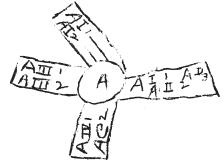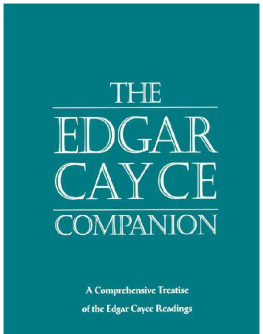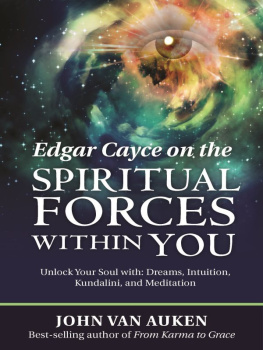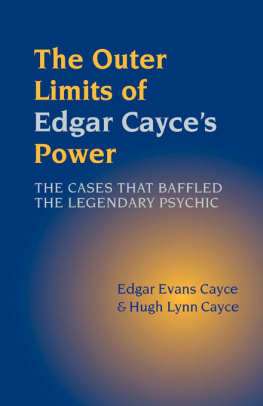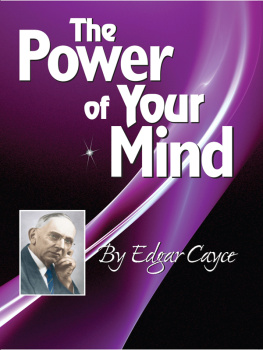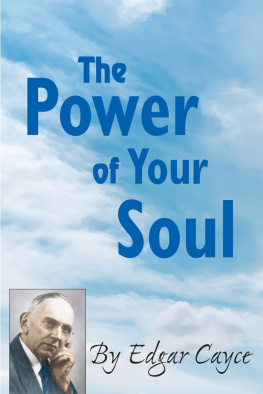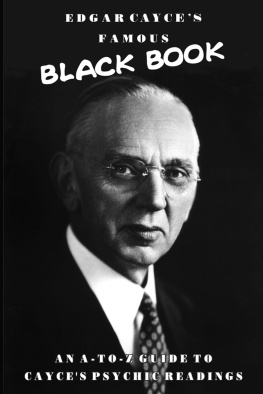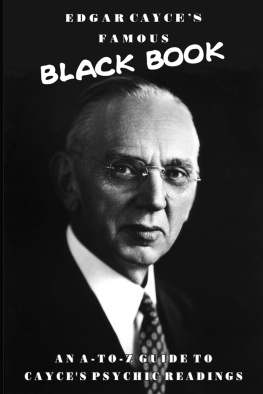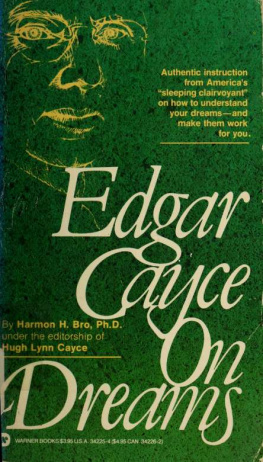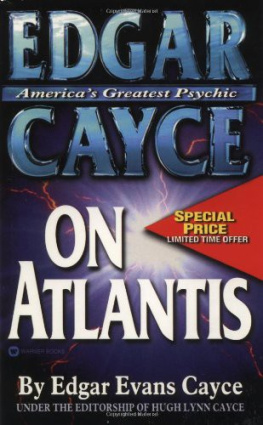Cayce Edgar. - Dreams and Visions
Here you can read online Cayce Edgar. - Dreams and Visions full text of the book (entire story) in english for free. Download pdf and epub, get meaning, cover and reviews about this ebook. genre: Science fiction / Religion. Description of the work, (preface) as well as reviews are available. Best literature library LitArk.com created for fans of good reading and offers a wide selection of genres:
Romance novel
Science fiction
Adventure
Detective
Science
History
Home and family
Prose
Art
Politics
Computer
Non-fiction
Religion
Business
Children
Humor
Choose a favorite category and find really read worthwhile books. Enjoy immersion in the world of imagination, feel the emotions of the characters or learn something new for yourself, make an fascinating discovery.
- Book:Dreams and Visions
- Author:
- Genre:
- Rating:5 / 5
- Favourites:Add to favourites
- Your mark:
- 100
- 1
- 2
- 3
- 4
- 5
Dreams and Visions: summary, description and annotation
We offer to read an annotation, description, summary or preface (depends on what the author of the book "Dreams and Visions" wrote himself). If you haven't found the necessary information about the book — write in the comments, we will try to find it.
Yo can learn a little about soul development and some understanding of dreams. Its difficult to read in places but still a good book
Dreams and Visions — read online for free the complete book (whole text) full work
Below is the text of the book, divided by pages. System saving the place of the last page read, allows you to conveniently read the book "Dreams and Visions" online for free, without having to search again every time where you left off. Put a bookmark, and you can go to the page where you finished reading at any time.
Font size:
Interval:
Bookmark:
By Edgar Cayce
Copyright 2008
by the Edgar Cayce Foundation
1st Printing, March 2009
Printed in the U.S.A.
All rights reserved. No part of this book may be reproduced or transmitted in any form or by any means, electronic or mechanical, including photocopying, recording, or by any information storage and retrieval system, without permission in writing from the publisher.
A.R.E. Press
215 67th Street
Virginia Beach, VA 23451-2061
Edgar Cayce Readings 1971, 1993-2007 by the Edgar Cayce Foundation. All rights reserved.
Cover design by Richard BoyleContents
Foreword: Who Was Edgar Cayce? ....................................................... vii
An Explanation of Cayces Discourses
by John Van Auken ................................................................................... xi
An Overview of Edgar Cayce on Dreams and Visions by Kristie E. Knutson ................................................................................ xv
Chapter 1
Chapter 2
Chapter 3
Chapter 4
Chapter 5
Chapter 6
dgar Cayce (1877-1945) has been called the sleeping prophet, the father of holistic medicine, the miracle man of Virginia Beach, and the most documented psychic of all time. For forty-three years of his adult life, he had the ability to put himself into some kind of self-induced sleep state by lying down on a couch, closing his eyes, and folding his hands over his stomach. This state of relaxation and meditation enabled him to place his mind in contact with all time and space and to respond to any question he was asked. His responses came to be called readings and contain insights so valuable that, even to this day, Cayces work is known throughout the world. Hundreds of books have explored his amazing psychic gift, and the entire range of Cayce material is accessed by tens of thousands of people daily via the Internet.
Although the vast majority of the Cayce material deals with health and every manner of illness, countless topics were explored by Cayces psychic talent: dreams, philosophy, intuition, business advice, the Bible, education, child rearing, ancient civilizations, personal spirituality, improving human relationships, and much more. In fact, during Cayces lifetime he discussed an amazing ten thousand different subjects!
The Cayce legacy presents a body of information so valuable that Edgar Cayce himself might have hesitated to predict its impact on contemporary society. Who could have known that eventually, terms such
viias meditation, auras, spiritual growth, reincarnation, and holism would become household words to millions? Edgar Cayces A.R.E. (the Association for Research and Enlightenment, Inc.) has grown from its humble beginnings to an association with Edgar Cayce Centers in countries around the world. Today the Cayce organizations consist of hundreds of educational activities and outreach programs, childrens camps, a multimillion-dollar publishing company, membership benefits and services, volunteer contacts and programs worldwide, massage and health services, prison and prayer outreach programs, conferences and workshops, and affiliated schools (Atlantic University and the Cayce/Reilly School of Massotherapy).
Edgar Cayce was born and reared on a farm near Hopkinsville, Kentucky. He had a normal childhood in many respects. However, he could see the glowing energy patterns that surround individuals. At a very early age he also told his parents that he could see and talk with his grandfatherwho was deceased. Later, he developed the ability to sleep on his schoolbooks and retain a photographic memory of their entire contents.
Eventually, he met and fell in love with Gertrude Evans, who would become his wife. Shortly thereafter, he developed a paralysis of the vocal cords and could scarcely speak above a whisper. Everything was tried, but no physician was able to locate a cause. The laryngitis persisted for months. As a last resort, hypnosis was tried. Cayce put himself to sleep and was asked by a specialist to describe the problem. While asleep, he spoke normally, diagnosing the ailment and prescribing a simple treatment. After the recommendations were followed, Edgar Cayce could speak normally for the first time in almost a year! The date was March 31, 1901that was the first reading.
When it was discovered what had happened, many others began to want help. It was soon learned that Edgar Cayce could put himself into this unconscious state and give readings for anyoneregardless of where he or she was. If the advice was followed, the individual got well. Newspapers throughout the country carried articles about his work, but it wasnt really until Gertrude was stricken with tuberculosis that the readings were brought home to him. Even with medical treatments, she continued to grow worse and was not expected to live. Finally, the
viiidoctors said there was nothing more they could do. A reading was given and recommended osteopathy, inhalants, enemas, dietary changes, and prescription medication. The advice was followed and Gertrude returned to perfectly normal health! For decades, the Cayce readings have stood the test of time, research, and extensive study. Further details of Cayces life and work are explored in such classic books as There Is a River (1942) by Thomas Sugrue, The Sleeping Prophet (1967) by Jess Stearn, Many Mansions (1950) by Gina Cerminara, and Edgar Cayce: An American Prophet (2000) by Sidney Kirkpatrick.
Throughout his life, Edgar Cayce claimed no special abilities, nor did he ever consider himself to be some kind of twentieth-century prophet. The readings never offered a set of beliefs that had to be embraced but instead focused on the fact that each person should test in his or her own life the principles presented. Though Cayce himself was a Christian and read the Bible from cover to cover for every year of his life, his work was one that stressed the importance of comparative study among belief systems all over the world. The underlying principle of the readings is the oneness of all life, a tolerance for all people, and a compassion and understanding for every major religion in the world.
dgar Cayce dictated all of his discourses from a self-induced trance. A stenographer took his discourses down in shorthand and later typed them. Copies were sent to the person or persons who had requested the psychic reading, and one was put into the files of the organization that built up around Cayce over the years: the Association for Research and Enlightenment (better known as the A.R.E.).
In his normal consciousness, Edgar Cayce spoke with a Southern accent but in the same manner as any other American. However, from the trance state, he spoke in the manner of the King James Bible, using thees and thous. In trance, his syntax was also unusual. He put phrases, clauses, and sentences together in a manner that slows down any reader and requires careful attention in order to be sure of his meaning. This caused his stenographer to adopt some unusual punctuation in order to put into sentence form some of the long, complex thoughts conveyed by Cayce while in trance. Also, many of his discourses are so jampacked with information and insights that it requires that one slow down and read more carefully in order to fully understand what he is intending.
From his trance state, Cayce explained that he got his information from two sources: (1) the inquiring individuals mind, mostly from his or her deeper, subconscious mind and (2) from the Universal Consciousness, the infinite mind within which the entire universe is conscious. He explained that every action and thought of every individual makes an impression upon the Universal Consciousness, an impression that can be psychically read. He correlated this with the Hindu concept of an Akashic Record, which is an ethereal, fourth-dimensional film upon which actions and thoughts are recorded and can be read at any time.
Font size:
Interval:
Bookmark:
Similar books «Dreams and Visions»
Look at similar books to Dreams and Visions. We have selected literature similar in name and meaning in the hope of providing readers with more options to find new, interesting, not yet read works.
Discussion, reviews of the book Dreams and Visions and just readers' own opinions. Leave your comments, write what you think about the work, its meaning or the main characters. Specify what exactly you liked and what you didn't like, and why you think so.

